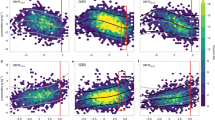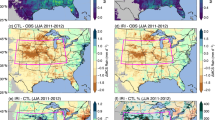Abstract
Moisture and heat fluxes from the land surface to the atmosphere form a critical nexus between surface hydrology and atmospheric processes, particularly those relevant to precipitation. Although current theory suggests that soil moisture generally has a positive impact on subsequent precipitation, individual studies have shown support both for1,2,3,4 and against5,6,7 this positive feedback. Broad assessment of the coupling between soil moisture and evapotranspiration, and evapotranspiration and precipitation, has been limited by a lack of large-scale observations. Quantification of the influence of evapotranspiration on precipitation remains particularly uncertain. Here, we develop and apply physically based, objective metrics for quantifying the impacts of surface evaporative and sensible heat fluxes on the frequency and intensity of convective rainfall during summer, using North American reanalysis data. We show that high evaporation enhances the probability of afternoon rainfall east of the Mississippi and in Mexico. Indeed, variations in surface fluxes lead to changes in afternoon rainfall probability of between 10 and 25% in these regions. The intensity of rainfall, by contrast, is largely insensitive to surface fluxes. We suggest that local surface fluxes represent an important trigger for convective rainfall in the eastern United States and Mexico during the summer, leading to a positive evaporation–precipitation feedback.
This is a preview of subscription content, access via your institution
Access options
Subscribe to this journal
Receive 12 print issues and online access
$259.00 per year
only $21.58 per issue
Buy this article
- Purchase on Springer Link
- Instant access to full article PDF
Prices may be subject to local taxes which are calculated during checkout




Similar content being viewed by others
References
Koster, R. D., Suarez, M. J., Higgins, R. W. & Van den Dool, H. M. Observational evidence that soil moisture variations affect precipitation. Geophys. Res. Lett. 30, 1241 (2003).
Findell, K. L. & Eltahir, E. A. B. An analysis of the soil moisture-rainfall feedback, based on direct observations from Illinois. Water Resour. Res. 33, 725–735 (1997).
D’Odorico, P. & Porporato, A. Preferential states in soil moisture and climate dynamics. Proc. Natl Acad. Sci. USA 101, 8848–8851 (2004).
Clark, D. B., Taylor, C. M. & Thorpe, A. J. Feedback between the land surface and rainfall at convective length scales. J. Hydrometeorol. 5, 625–639 (2004).
Georgakakos, K. P., Bae, D-H. & Cayan, D. R. Hydroclimatology of continental watersheds, 1. Temporal analysis. Water Resour. Res. 31, 655–675 (1995).
Cook, B. I., Bonan, G. B. & Levis, S. Soil moisture feedbacks to precipitation in southern Africa. J. Clim. 19, 4198–4206 (2006).
Giorgi, F., Mearns, L. O., Shields, C. & Mayer, L. A regional model study of the importance of local versus remote controls of the 1988 drought and the 1993 flood over the central United States. J. Clim. 9, 1150–1162 (1996).
Guo, Z. et al. GLACE: The global land–atmosphere coupling experiment. Part II: Analysis. J. Hydrometeorol. 7, 611–625 (2006).
Mahanama, S. P. P. & Koster, R. D. AGCM biases in evaporation regime: Impacts on soil moisture memory and land–atmosphere feedback. J. Hydrometeorol. 6, 656–669 (2005).
Hohenegger, C., Brockhaus, P., Bretherton, C. S. & Schär, C. The soil moisture-precipitation feedback in simulations with explicit and parameterized convection. J. Clim. 22, 5003–5020 (2009).
Koster, R. D. & Suarez, M. J. Impact of land surface initialization on seasonal precipitation and temperature prediction. J. Hydrometeorol. 4, 408–423 (2003).
Mesinger, F. et al. North American regional reanalysis. Bull. Am. Meteorol. Soc. 87, 343–360 (2006).
Seneviratne, S. I. et al. Investigating soil moisture–climate interactions in a changing climate: A review. Earth Sci. Rev. 99, 125–161 (2010).
Mahfouf, J-F. Analysis of soil moisture from near-surface parameters—a feasibility study. J. Appl. Meteorol. 30, 1534–1547 (1991).
Findell, K. L. & Eltahir, E. A. B. Atmospheric controls on soil moisture-boundary layer interactions: Part I: Framework development. J. Hydrometeorol. 4, 552–569 (2003).
Betts, A. K. Land–surface–atmosphere coupling in observations and models. J. Adv. Model. Earth Syst. 1, 4 (2009).
Alfieri, L., Claps, P., D’Odorico, P., Laio, F. & Over, T. M. An analysis of the soil moisture feedback on convective and stratiform precipitation. J. Hydrometeorol. 9, 280–291 (2008).
Von Storch, H. & Zwiers, F. W. Statistical Analysis in Climate Research (Cambridge Univ. Press, 1999).
Findell, K. L. & Eltahir, E. A. B. Atmospheric controls on soil moisture-boundary layer interactions: Part II: Feedbacks within the continental United States. J. Hydrometeorol. 4, 570–583 (2003).
Zhang, Y. & Klein, S. A. Mechanisms affecting the transition from shallow to deep convection over land: Inferences from observations of the diurnal cycle collected at the ARM Southern Great Plains site. J. Atmos. Sci. 67, 2943–2959 (2010).
Romps, D. M. & Kuang, Z. Nature versus Nurture in Shallow Convection. J. Atmos. Sci. 67, 1655–1666 (2010).
Schär, C., Lüthi, D., Beyerle, U. & Heise, E. The soil-preciptation feedback: A process study with a regional climate model. J. Clim. 12, 722–741 (1999).
Koster, R. et al. Regions of strong coupling between soil moisture and precipitation. Science 305, 1138–1140 (2004).
Lintner, B. R. & Neelin, J. D. Soil moisture impacts on convective margins. J. Hydrometeorol. 10, 1026–1039 (2009).
R, Koster et al. GLACE: The global land–atmosphere coupling experiment. Part I: Overview. J. Hydrometeorol. 7, 590–610 (2006).
De Ridder, K. Land surface processes and the potential for convective precipitation. J. Geophys. Res. 102, 30085–30090 (1997).
Lin, J. W. B. & Neelin, J. D. Toward stochastic deep convective parameterization in general circulation models. Geophys. Res. Lett. 30, 1162 (2003).
Milly, P. C. D. et al. Stationarity is dead: Whither water management? Science 319, 573–574 (2007).
Seneviratne, S. I., Lüthi, D., Litschi, M. & Schär, C. Land–atmosphere coupling and climate change in Europe. Nature 443, 205–209 (2006).
Cragoa, R. & Brutsaert., W. Daytime evaporation and the self-preservation of the evaporative fraction and the Bowen ratio. J. Hydrolol. 178, 241–255 (1996).
Acknowledgements
We thank R. Stouffer, S. Malyshev, F. D’Andrea, S. Seneviratne and A. Berg for providing comments on the manuscript. We thank A. Wittenberg for help with the determination of ENSO years. P.G. and B.R.L. are supported by an NSF grant and B.R.L. is also supported by a NOAA grant and an NJAES Hatch grant. National Centers for Environmental Prediction (NCEP) North American Regional Reanalysis (NARR) data provided by the National Climatic Data Center from their website: http://nomads.ncdc.noaa.gov/data.php.
Author information
Authors and Affiliations
Contributions
K.L.F. performed the analysis of the data and wrote the paper. K.L.F., P.G. and B.R.L. jointly designed and refined the study. P.G. and B.R.L. contributed equally to the work. C.K. converted the original data to netCDF format. All authors discussed the results and commented on the manuscript.
Corresponding author
Ethics declarations
Competing interests
The authors declare no competing financial interests.
Supplementary information
Supplementary Information
Supplementary Information (PDF 1371 kb)
Rights and permissions
About this article
Cite this article
Findell, K., Gentine, P., Lintner, B. et al. Probability of afternoon precipitation in eastern United States and Mexico enhanced by high evaporation. Nature Geosci 4, 434–439 (2011). https://doi.org/10.1038/ngeo1174
Received:
Accepted:
Published:
Issue Date:
DOI: https://doi.org/10.1038/ngeo1174
This article is cited by
-
Urbanization alters atmospheric dryness through land evapotranspiration
npj Climate and Atmospheric Science (2023)
-
Soil moisture−atmosphere feedbacks have triggered the shifts from drought to pluvial conditions since 1980
Communications Earth & Environment (2023)
-
Global water availability boosted by vegetation-driven changes in atmospheric moisture transport
Nature Geoscience (2022)
-
Soil moisture signature in global weather balloon soundings
npj Climate and Atmospheric Science (2021)
-
Impacts of land cover heterogeneity and land surface parameterizations on turbulent characteristics and mesoscale simulations
Meteorology and Atmospheric Physics (2021)



